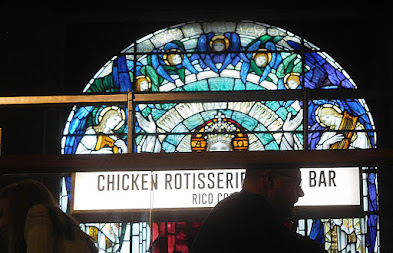NAPOLEON
BONAPARTE DIED in captivity on the tiny island of St Helena in the south
Atlantic. While he was imprisoned on the island, Lieutenant General Sir Hudson Lowe
(1769-1844) was the Governor of St Helena. He was buried at St Mark’s Church in
North Audley Street in London’s Mayfair, where a commemorative plaque can be
found by the main entrance. St Mark’s was built in the Greek Revival Style in
1825-28, designed by John Peter Gandy (1787-1850). In 1878, the church
architect Arthur Blomfield (1829-1899) made considerable alterations to its
interior including adding a timber vaulted ceiling over the nave.
During
the 1950s and 1960s, the size of St Mark’s congregation diminished significantly.
In 1974, the church was made redundant, and this is how it remained until 1994,
when the church was used by The Commonwealth Christian Fellowship. It continued
to serve this group until 2008. After that, it was used as a venue for
occasional events. In about 2019 after a 5 million Pound restoration programme,
the church underwent a surprising reincarnation.
After
passing beneath the grand portico supported by two columns topped with ionic
capitals, one enters the church’s large vestibule. Since 2019, this has become
a marketplace selling upmarket Italian delicatessen goods. Entering the body of
the church is rather like taking part in a Fellini film. The floor of the nave is
filled with tables and chairs and people drinking and dining. The side aisles,
north and south, contain several kitchens, preparing and serving a wide variety
of foods, from Turkish to Thai. On the north side of the chancel, just behind
the neo-gothic stone pulpit, there is a gin bar, and facing it on the south
side of the chancel, there is another bar providing alcoholic refreshments. Look
upwards and you can admire the splendid timber roof supports. The wide gallery
surrounding the nave at the first-floor level is home to more food stalls, each
offering tempting looking fare at not unreasonable prices, especially by local
Mayfair standards.
In
2019, the church became home to a branch of Mercato Metropolitano, whose first
venture was converting a 150,000 square foot disused railway station in Milan during
the 2015 World Expo in that Italian city. The idea of the company was: “The
development of the first Mercato Metropolitano was carefully planned to retain
the site’s original appearance, which nurtured the local community’s affection
for a special part of their urban history.” (https://www.mercatometropolitano.com/mmarketplace/#the-mercato-story).
And
this is what has been done at the former St Mark’s in Mayfair. Many of the
church’s fittings (for example, the tiled floors, the stained glass, the monuments,
the pulpit, and the sacred paintings at the east end of the chancel) have been
preserved. Entering the church is like entering the scene of a lively gargantuan
feast. Seeing the large number of customers on a weekday lunchtime demonstrates
that Mercato Metropolitano have successfully created a great place to meet,
eat, and drink. It is highly original and exciting, both visually and
gastronomically.
In
Chapter 21 (verses 12-13) of the Gospel according to Matthew, we learn that: “…Jesus
went into the temple of God, and cast out all them that sold and bought in the
temple, and overthrew the tables of the money changers, and the seats of them
that sold doves, And said unto them, It is written, My house shall be called
the house of prayer; but ye have made it a den of thieves.” I
just cannot help wondering, as many of you might also be doing, what The Good
Lord would have made of what can now be seen inside the Church of St Mark’s in
Mayfair. |
Tuesday, 9 November 2021
GIN AND TONIC BEHIND THE PULPIT AND CHICKEN IN THE CHURCH
Subscribe to:
Post Comments (Atom)












No comments:
Post a Comment
Useful comments and suggestions are welcome!